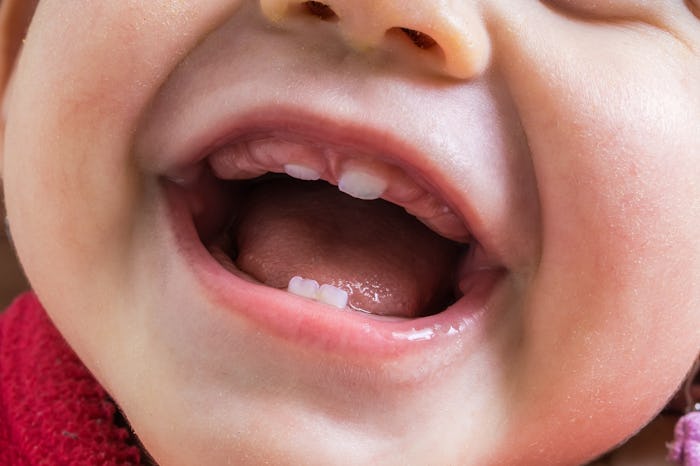Life
How To Know If Your Baby Is *Actually* Teething & How Long It'll Take
After bringing home your newborn baby, it may take a few weeks to get into the swing of things. Then once you’ve got your feeding, sleeping, and diapering routine down pat, your baby will begin teething, throwing your whole schedule off track. Teething babies can be fussy about everything, so you’ll want to know if those elusive teeth will ever make an appearance. So how long does teething take before a tooth appears? Because the misery can't last forever.
In an interview with Romper, Pennsylvania pediatrician, Dr. Jarret Patton says that when your baby is truly teething, their gums will be swollen and you may notice them drooling more. “Teething can occur at anytime,” explains Patton, “but swollen gums usually give way to teeth within a month or so.” If you have been noticing your baby’s gums getting extra puffy, it may just be a matter of weeks before you see a pearly white starting to poke through.
It’s important to know if your baby is even teething in the first place. Patton says that teething is often misdiagnosed by parents in early infancy when they see their babies drooling or putting their hands in their mouth. But, he says, this isn't really teething. “This is actually just a normal phase in development,” notes Patton: “the baby’s oral phase.”
When your baby is teething, you’ll notice other signs, along with the swollen gums and drooling. According to Parenting, teething babies will often try to gnaw and chew on anything they can get into their mouth. If your baby’s teething pain crosses over to their ear canal, they noted, you may find them tugging at their ears too. Parenting further mentioned that you might even notice a change in their eating habits, depending on how the pressure of the sucking down milk or chewing on foods makes them feel. Some babies may want to drink more milk than eat solids, while other babies may do the opposite.
You may not be able to pinpoint when exactly your baby’s teeth are supposed to come in, because there isn’t really a hard set timeline. Every baby is different, and their teeth will show up at different times too. There is, however, a general time frame and order in which the average baby’s teeth come in. The American Academy of Pediatrics’ (AAP) Healthy Children website explained that between 6 to 12 months, most babies will cut their first lower and upper central incisors. After that, you’ll see their lower and upper lateral incisors, first molars, canines, and then their second molars leading up to the age of two.
If you do have a fussy, teething baby on your hands, there are things you can do to ease their pain (and yours). The AAP suggested that you massage your baby’s gums with your finger, a teether (avoid liquid-filled ones), or a wet or frozen washcloth. I’ve heard of parents giving their babies frozen bagels and biscuits in place of a teether, but the AAP noted that if big enough chunks are bitten off, they could become a choking hazard. So keep a close eye on your baby when doing so.
The AAP also warned against the use of homeopathic pills and topical anesthetics designed to numb out gum pain. They explained that the belladonna found in many of these homeopathic remedies, and the benzocaine found in the oral gels, are known to have potential side effects and are under scrutiny from the Federal Drug Administration (FDA). In the last few years, I’ve seen parents putting amber beaded necklaces around their babies’ necks to help with the teething pain. Dr. Dina Kulik cautioned on the Today's Parent site that there is no "scientific evidence that teething necklaces are effective or safe. In fact, they’re potentially dangerous because of the risk of choking — if a child were to break the necklace and swallow the beads — and strangulation."
If you do decide to use an amber necklace, take extra caution. PediatricEducation.org recounted an instance where a pediatrician recommended to a mother that the necklace "can it be pinned to the inside of the clothing still touching the skin, or even placed on an ankle where it is less likely for her to be strangled or for her to get a loose bead into her mouth."
Luckily, if your baby is teething, it shouldn't be long before you see a tooth come through. In the meantime, you can ask your doctor about giving your baby acetaminophen or ibuprofen for pain, and continue to massage their gums for comfort. But the thing your baby needs most from you right now, is a little patience and lots of love.
Check out Romper's new video series, Bearing The Motherload, where disagreeing parents from different sides of an issue sit down with a mediator and talk about how to support (and not judge) each other’s parenting perspectives. New episodes air Mondays on Facebook.
